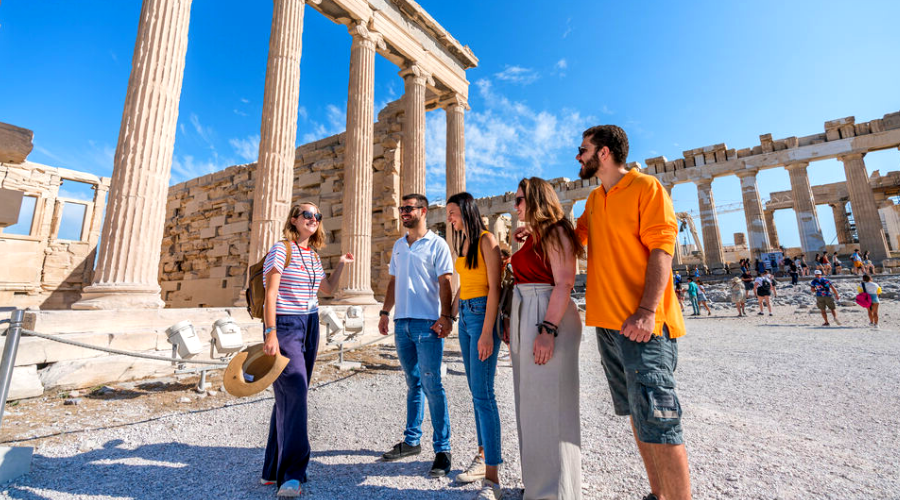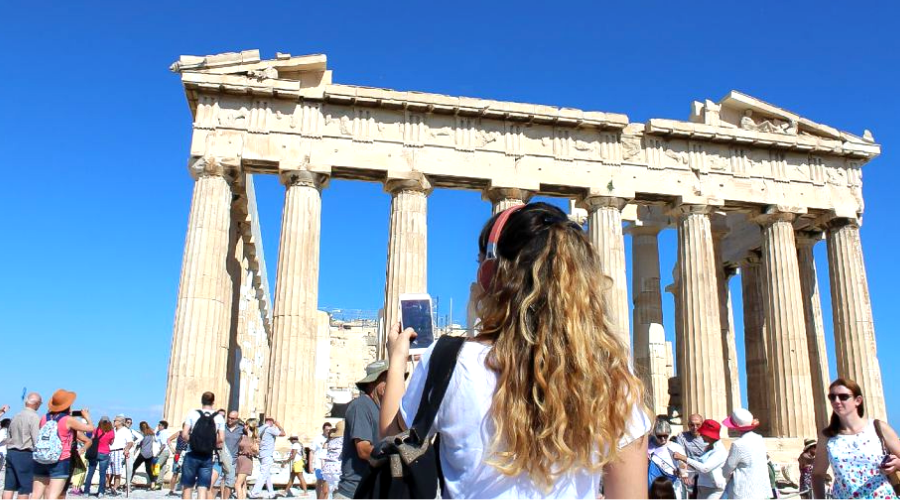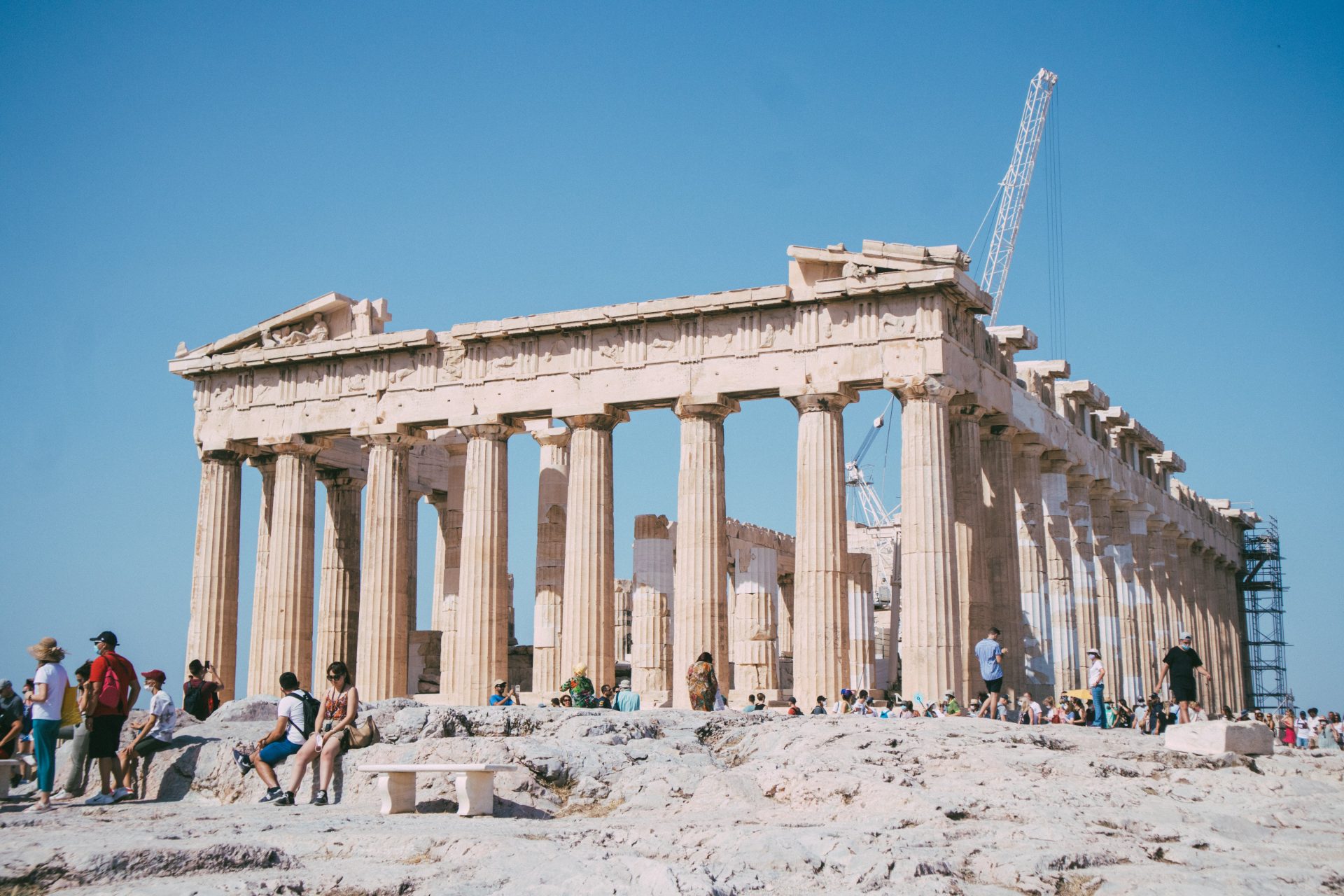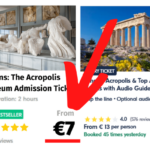The
The Acropolis of Athens Key Facts:
-
The
Acropolis of Athens is a UNESCO World Heritage site. It is one of the most famous archaeological sites in the world. -
Located on a rocky hilltop in Athens, Greece, it overlooks the city.
-
The word “Acropolis” means “high city” in Greek.
-
The Parthenon is the most iconic structure within the
Acropolis . It is a temple dedicated to the goddess Athena.
 Acropolis and 6 Archaeological Sites Combo Ticket
Acropolis and 6 Archaeological Sites Combo Ticket
- Skip-the-line
- Free cancellation.
History:
-
The construction of the
Acropolis began in the 5th century BCE. It took place during the Golden Age of Athens. Pericles led the way. -
The main purpose of the
Acropolis was religious and civic. It served as a sanctuary and a symbol of Athenian power and culture. -
The buildings on the
Acropolis underwent various changes and renovations over the centuries. This included the addition of temples, statues, and defensive fortifications. -
The
Acropolis also played a significant role in the history of Greece. It witnessed wars, invasions, and power changes throughout the ages.
 The Official Ticketing Site for Acropolis Tickets online | GUIDE 2024
The Official Ticketing Site for Acropolis Tickets online | GUIDE 2024
Before Purchasing from the official website of the Greek government Please Note
Visitor Information:
-
The
Acropolis is open all year round. It has slightly different opening hours depending on the season. Generally, it opens in the morning and closes in the evening. To get the latest hours, check the official website or ticketing platform. -
As mentioned earlier, we recommend purchasing tickets online in advance. This way you can secure your entry and avoid long queues. You can buy online tickets from trusted platforms like GetYourGuide, Viator, or Tiqets. You can also buy them from the official ticketing website.
-
Types of Tickets: Various ticket options are available. They include regular admission tickets and skip-the-line tickets for faster entry. Some tickets may include access to other archaeological sites or attractions in Athens.
-
Guided tours are available and highly recommended. They help you gain a deeper understanding of the history and significance of the
Acropolis . Guided tours help visitors better understand theAcropolis ‘s history and significance. You can join a group tour or opt for a private guided experience. -
The
Acropolis has restrooms, a visitors’ center, and a museum. You can learn more about the artifacts discovered on the site in the museum. -
Accessibility: The
Acropolis is a historical site situated on a hill. Visitors may need to walk uphill and navigate steps. However, stakeholders have tried improving accessibility for visitors with mobility challenges.
Remember to wear comfortable shoes. Bring water and protect yourself from the sun during your visit. Be respectful of the site. Follow any guidelines or instructions provided by the staff.
Exploring the
Here’s more information about the Acropolis of Athens:
-
The
Acropolis has gained renown as an architectural marvel. Its architectural brilliance and harmonious design are well-known. It showcases the mastery of ancient Greek architects and craftsmen. The Parthenon is the most famous structure. It is a Doric temple dedicated to the goddess Athena. Its intricate details and refined proportions make it a masterpiece. It’s an example of Classical Greek architecture. -
Iconic Monuments: Besides the Parthenon, the
Acropolis houses other notable monuments. The Erechtheion is a temple known for its graceful female figures. They are the Caryatids, supporting its porch. The Temple of Athena Nike stands as a testament to victory. The Propylaea serves as an impressive entrance gate to theAcropolis . -
The
Acropolis played a central role in the history of Athens and Ancient Greece. It is historically significant. It was a symbol of power, democracy, and cultural achievements. The site witnessed important events. These include the Persian Wars and the establishment of Athenian democracy. It also served as the treasury of the Delian League, an alliance of Greek city-states. -
The Acropolis Museum is adjacent to the
Acropolis . It houses a vast collection of sculptures, artifacts, and architectural fragments. Researchers discovered these on the site. The museum offers a comprehensive understanding of theAcropolis ‘ history. It also explains the significance of its various structures. Don’t miss the opportunity to explore its fascinating exhibits. -
Climbing to the top of the
Acropolis rewards visitors with breathtaking panoramic views of Athens. From this vantage point, you can see the sprawling cityscape. You can also see the surrounding hills and the distant Aegean Sea. It’s a perfect spot for capturing memorable photos. It’s also a great place to appreciate the beauty of Athens. -
Efforts to preserve and restore the
Acropolis have been ongoing for many years. We constantly make efforts to protect and maintain the site’s integrity. We use modern techniques and materials to restore damaged structures. These preservation endeavours ensure that future generations can continue to admire and learn from this ancient wonder. -
The
Acropolis is not only an archaeological site. It is also a symbol of Greek culture and heritage. It holds immense cultural value for Greeks and serves as a source of national pride. Modern architecture, art, and literature reflect its influence, inspiring creativity and admiration.
What other attractions are near the Acropolis ?
After exploring the
-
Just a short walk from the
Acropolis , you can find the Ancient Agora. It was the heart of ancient Athens’ civic life. This archaeological site features ruins of various structures. These include the Stoa of Attalos, the Temple of Hephaestus, and the Bouleuterion (Council House). It offers a fascinating glimpse into the daily life and governance of ancient Athens. -
The Plaka Neighborhood is next to the
Acropolis . It is a charming area with narrow streets, neoclassical buildings, and traditional tavernas. Take a stroll through its picturesque alleys. Visit local shops for souvenirs. Enjoy a meal at one of the many restaurants serving delicious Greek cuisine. -
The Temple of Olympian Zeus is a short distance from the
Acropolis . It is one of the largest temples of the ancient world. Although now mostly in ruins, it still retains an impressive presence. Marvel at the towering columns that remain. Imagine the grandeur of this once-magnificent temple. -
If you have a keen interest in ancient history, the National Archaeological Museum is a must-visit. It houses an extensive collection of artifacts from various archaeological sites throughout Greece. Explore the exhibits showcasing sculptures, pottery, jewelry, and other artifacts. They span thousands of years of Greek history.
-
People know the Panathenaic Stadium as the birthplace of the modern Olympic Games. It is a historic site worth visiting. The marble stadium was originally constructed in the 4th century BCE. The restoration enables it to host various events. Take a walk through its grandstands. Imagine the ancient athletes competing in their athletic pursuits.
These are just a few suggestions. Athens has much more to offer, including attractions, museums, and cultural experiences. You may want to explore the Benaki Museum or the National Garden, depending on your interests. You could also take a day trip to nearby destinations like Cape Sounion or Delphi.
Enjoy your exploration of Athens beyond the
What are some notable artefacts and sculptures that can be found in the Acropolis Museum?
the
- Parthenon Frieze: The Parthenon Frieze is one of the most significant sculptural works from the
Acropolis . It adorned the exterior of the Parthenon and depicts the Panathenaic Procession, a grand festival in honour of the goddess Athena. - Caryatids: The
Acropolis Museum is home to five of the original six Caryatids, which once adorned the Erechtheion. These female figures, with their flowing drapery and unique poses, serve as iconic symbols of Greek architecture. - Acropolis Kore: The
Acropolis Kore is a collection of statues representing young women. These sculptures, with their elegant drapery and serene expressions, showcase the artistic skill of the time and were offerings to the goddess Athena. - Moschophoros: The Moschophoros, also known as the “Calf Bearer,” is a famous sculpture that portrays a young man carrying a calf on his shoulders. It is a testament to the skill of ancient Greek sculptors in capturing lifelike details.
- Athena Nike Temple Sculptures: The
Acropolis Museum displays several architectural fragments and sculptures from the Temple of Athena Nike. These include friezes, statues, and reliefs, showcasing the intricate artwork associated with this small but significant temple. - Archaic Gallery: The museum’s Archaic Gallery houses a collection of striking statues and sculptures from the Archaic period. These artworks reflect the evolution of Greek sculpture, from the stiff and rigid forms of earlier times to the beginnings of a more naturalistic style.
- Pediments and Metopes: The
Acropolis Museum also exhibits fragments of the pediments and metopes of the Parthenon. These sculptural elements depict various mythological and historical scenes, showcasing the storytelling abilities of ancient Greek artists.
These are just a few examples of the remarkable artifacts and sculptures you can explore at the
What other sculptures are displayed in the Archaic Gallery at the Acropolis Museum?
Ah, in the Archaic Gallery of the
- Kouroi and Korai: The Archaic Gallery showcases a collection of Kouroi and Korai statues. Kouroi are freestanding male statues, typically depicted in a standing position with their arms at their sides. Korai, on the other hand, are female statues, often depicted in flowing garments and with a more naturalistic posture. These sculptures represent the transition from the rigid, stylized forms of the earlier archaic period to a more lifelike representation.
- Peplos Kore: One of the most famous sculptures in the Archaic Gallery is the Peplos Kore. This statue of a young woman, adorned in a peplos garment, exemplifies the idealized beauty of the time. The statue was originally painted, and traces of the vibrant pigments can still be seen, offering a glimpse into the ancient world’s colourful aesthetics.
- Rampin Horseman: Another remarkable sculpture on display is the Rampin Horseman. This fragmentary work depicts a horseman riding a rearing horse and is believed to have been a part of a larger composition. It showcases the skill of Archaic sculptors in capturing movement and conveying a sense of dynamic energy.
- Sounion Kouros: The Sounion Kouros is a colossal statue of a young man found at Cape Sounion, near Athens. This impressive sculpture stands over 3 meters tall and exhibits the archaic style with its rigid pose and a smile known as the “Archaic smile.” It is a striking example of the monumental scale and artistic prowess of the period.
- Head of a Bearded Man: The Head of a Bearded Man is a fragmentary sculpture that captures the individualized features and facial expressions of an older man. It showcases the emerging naturalistic tendencies of Archaic art and provides a glimpse into the portraiture of the time.
These sculptures in the Archaic Gallery offer valuable insights into the artistic development and stylistic characteristics of the Archaic period in ancient Greece. They provide a fascinating link between the rigid forms of earlier times and the more naturalistic approach that would come to define classical Greek art.
 Before you buy tickets, read the guide for 2024. Click Here
Before you buy tickets, read the guide for 2024. Click Here



